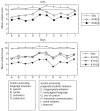Autism, language and communication in children with sex chromosome trisomies
- PMID: 20656736
- PMCID: PMC3182523
- DOI: 10.1136/adc.2009.179747
Autism, language and communication in children with sex chromosome trisomies
Abstract
Purpose: Sex chromosome trisomies (SCTs) are found on amniocentesis in 2.3-3.7 per 1000 same-sex births, yet there is a limited database on which to base a prognosis. Autism has been described in postnatally diagnosed cases of Klinefelter syndrome (XXY karyotype), but the prevalence in non-referred samples, and in other trisomies, is unclear. The authors recruited the largest sample including all three SCTs to be reported to date, including children identified on prenatal screening, to clarify this issue.
Design: Parents of children with a SCT were recruited either via prenatal screening or via a parental support group, to give a sample of 58 XXX, 19 XXY and 58 XYY cases. Parents were interviewed using the Vineland Adaptive Behavior Scales and completed questionnaires about the communicative development of children with SCTs and their siblings (42 brothers and 26 sisters).
Results: Rates of language and communication problems were high in all three trisomies. Diagnoses of autism spectrum disorder (ASD) were found in 2/19 cases of XXY (11%) and 11/58 XYY (19%). After excluding those with an ASD diagnosis, communicative profiles indicative of mild autistic features were common, although there was wide individual variation.
Conclusions: Autistic features have not previously been remarked upon in studies of non-referred samples with SCTs, yet the rate is substantially above population levels in this sample, even when attention is restricted to early-identified cases. The authors hypothesise that X-linked and Y-linked neuroligins may play a significant role in the aetiology of communication impairments and ASD.
Figures
References
-
- Morris JK, Alberman E, Scott C, et al. Is the prevalence of Klinefelter syndrome increasing? Eur J Hum Genet. 2008;16:163–70. - PubMed
-
- Willard HF. The sex chromosomes and X chromosome inactivation. In: Scriver C, Beaudet A, Sly W, Valle D, editors. The metabolic and molecular bases of inherited disease. 7th edn. McGraw Hill; New York, USA: 1995. pp. 719–35.
-
- Bender BG, Berch DB. Overview: psychological phenotypes and sex chromosome abnormalities. In: Berch D, Bender B, editors. Sex Chromosome Abnormalities and Human Behavior. Westview; Boulder, Colorado, USA: 1990. pp. 1–19.
-
- Bender BG, Harmon RJ, Linden MG, et al. Psychosocial competence of unselected young adults with sex chromosome abnormalities. Am J Med Genet. 1999;88:200–6. - PubMed
Publication types
MeSH terms
Grants and funding
LinkOut - more resources
Full Text Sources

